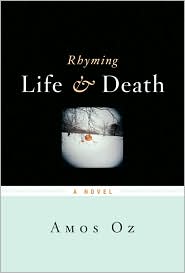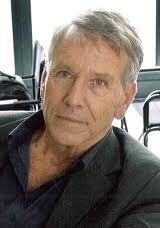“Why do you write? Why do you write the way you do? Are you trying to influence your readers, and, if so, how? What role do your books play? Do you constantly cross out and correct or do you write straight out of your head? What is it like to be a famous writer and what effect does it have on your family?…And by the way, how would you define yourself?”
When the Author, the ot herwise unnamed main character of Amos Oz’s newest work, arrives at a literary evening at the Shunia Shor Community Center in Tel Aviv as the special guest, he expects the usual sorts of questions from his audience. What his audience never suspects is that the author, while answering their sometimes intrusive questions about himself, is secretly inventing names and imaginary lives for them, connecting them to each other, and even continuing his musings about them well into the night after the meeting is concluded. Approximately thirty-five characters, either in the audience or peripheral to the stories the Author is creating, dominate the Author’s interior life, even as the real humans behind these stories are talking with him about his work. When the audience leaves the community center, they are unaware of their continuing lives in the Author’s imagination.
herwise unnamed main character of Amos Oz’s newest work, arrives at a literary evening at the Shunia Shor Community Center in Tel Aviv as the special guest, he expects the usual sorts of questions from his audience. What his audience never suspects is that the author, while answering their sometimes intrusive questions about himself, is secretly inventing names and imaginary lives for them, connecting them to each other, and even continuing his musings about them well into the night after the meeting is concluded. Approximately thirty-five characters, either in the audience or peripheral to the stories the Author is creating, dominate the Author’s interior life, even as the real humans behind these stories are talking with him about his work. When the audience leaves the community center, they are unaware of their continuing lives in the Author’s imagination.
Among these characters is Tsefania Beit-Halachmi (also known as Avraham “Bumek” Schuldenfrei), an elderly poet who is the author of a collection of poems called Rhyming Life and Death.” The poems themselves echo throughout the book—mostly doggerel—as both the narrator/Author and the book’s author, Amos Oz, explore serious questions of life and death, and eventually some less serious questions of sex and death.

Following the meeting at the community center, the Author escorts the unattractive and painfully shy Rochele Reznik, home after the meeting, hoping for an evening of passion. His failure leads him to explore of the ideas of another invented character, Arnold Bartok, a part-time philosopher who has noted that “It is not life and death that came into the world as a pair, but sex and death.” Death, Bartok believes, “appeared aeons later than life,” when sexual reproduction was created, and it is sex that has led to aging and death. “We simply have to find a way of eliminating sex,” he says, “so as to rid our world of the inevitability of death, and of so much suffering as well.
Taking a modernist approach to writing, Oz plays with the form of the book, creating a wide cast of characters who exemplify the themes which he (and, of course the Author) wishes to explore, issues both serious and tongue in cheek. The attractive waitress at the café where the Author has coffee becomes “Ricky,” whose football-playing boyfriend “Charlie” has also enjoyed the favors of “Lucy,” runner-up in the Queen of the Waves contest, who married the son of Ovadya Hazzam, who won a lottery and is now dying of cancer in a miserable hospital room. Miriam Nehorait, a middle-aged culture lover at the meeting, may have had a relationship with a sixteen-year-old, unhappy and hypersensitive young poet in the audience, who is anxious to have the Author read his poems, and they may have been observed by yet another woman, a neighborhood snoop. Arnold Bartok’s mother, age 86, and paralyzed from the waist down sleeps beside him at night, while Yerucham Shdemati is dying of a blood disease. The lecturer Bar-Orian, widowed twice and living alone, has been abandoned by his only daughter. Life is difficult and usually painful; death is inevitable—and also painful.
 Life and death and love and sex echo throughout the novella, as the Author wends his way through the city after his literary evening, thinking about his characters and not always willing or able to differentiate between his imaginative life and his real life. Twice divorced, he himself is returning to an empty apartment at four a.m. When he arrives, the alarm system of a car is screaming because it “can no longer bear its loneliness.” The man on the other side of the Author’s apartment wall is weeping, and a nightbird is shrieking. When the Author opens the local newspaper before going to bed, he discovers that Tsefania Beit-Halachmi, the author of Rhyming Life and Death, has just died. “Once in a while it is worth turning on the light to clarify what is going on,” he declares simply.
Life and death and love and sex echo throughout the novella, as the Author wends his way through the city after his literary evening, thinking about his characters and not always willing or able to differentiate between his imaginative life and his real life. Twice divorced, he himself is returning to an empty apartment at four a.m. When he arrives, the alarm system of a car is screaming because it “can no longer bear its loneliness.” The man on the other side of the Author’s apartment wall is weeping, and a nightbird is shrieking. When the Author opens the local newspaper before going to bed, he discovers that Tsefania Beit-Halachmi, the author of Rhyming Life and Death, has just died. “Once in a while it is worth turning on the light to clarify what is going on,” he declares simply.
Though the “novel” blurs the boundaries of reality and imagination and leaves a number of loose ends and undeveloped ideas, Oz provides an unusual and creative meditation on his themes and on the transience of happiness, life, love, and fame. Often darkly humorous and ironic, the author offers few glimmers of hope for the future, however. Life is what it is, and though we can escape from reality through dreams and our imaginations, Oz lets us know that sooner or later we must all “turn on the light to clarify what is going on.” It is not much to look forward to. “Tomorrow,” he tells us, “will be warm and humid, too. And, in fact, tomorrow is today.”
Notes: Other novels by Amos Oz reviewed here: PANTHER IN THE BASEMENT, SOUMCHI, MY MICHAEL, A TALE OF LOVE AND DARKNESS , SCENES FROM VILLAGE LIFE, JUDAS
Photos, in order: The author’s photo accompanies a story (in Spanish) wondering about the chances of Amos Oz winning the Nobel Prize for Literature: http://www.justa.com
The street scene at night in Tel Aviv is from http://themusicunderground.wordpress.com
